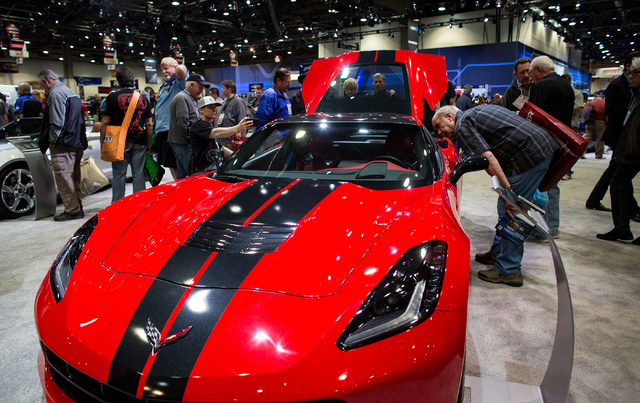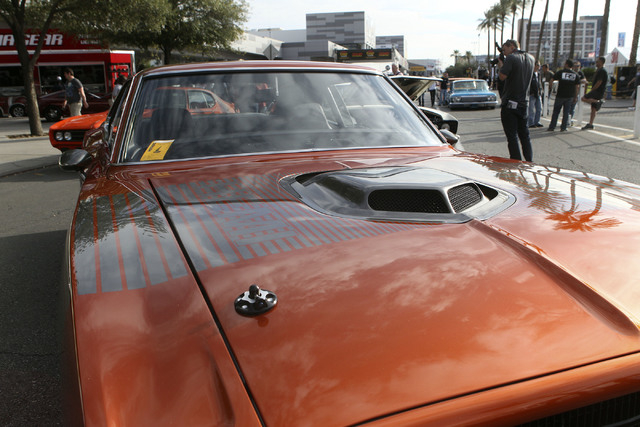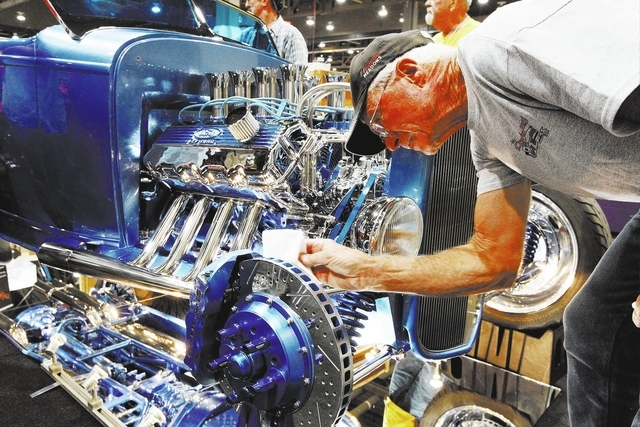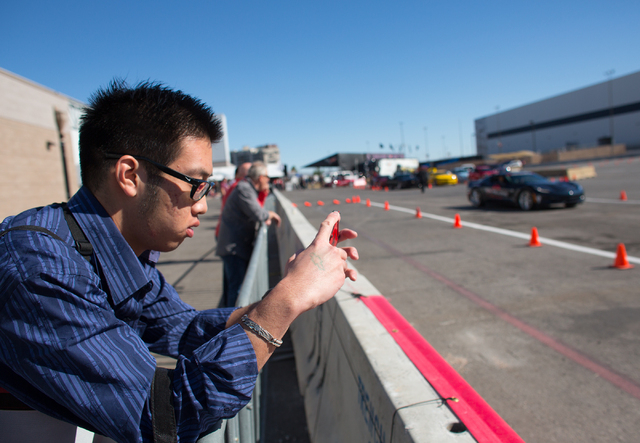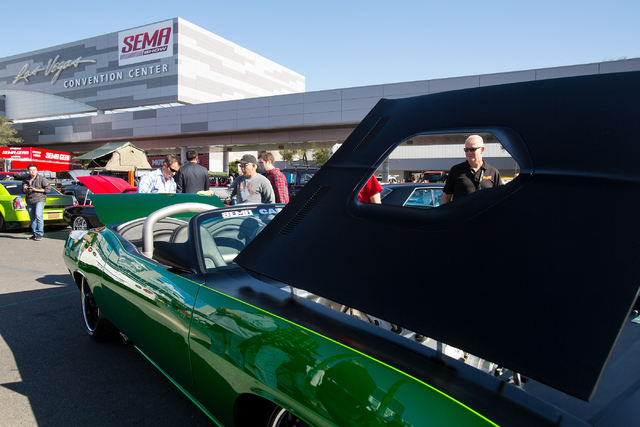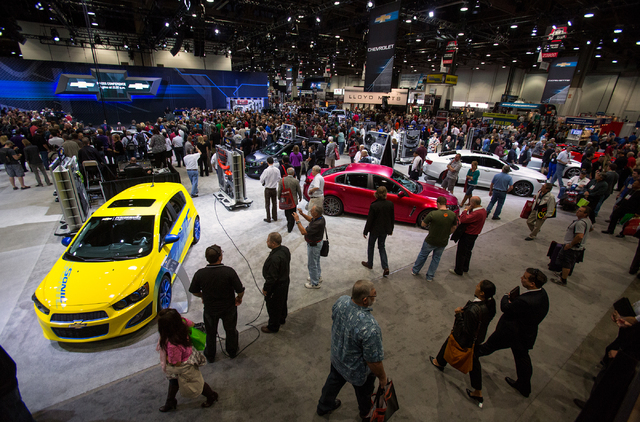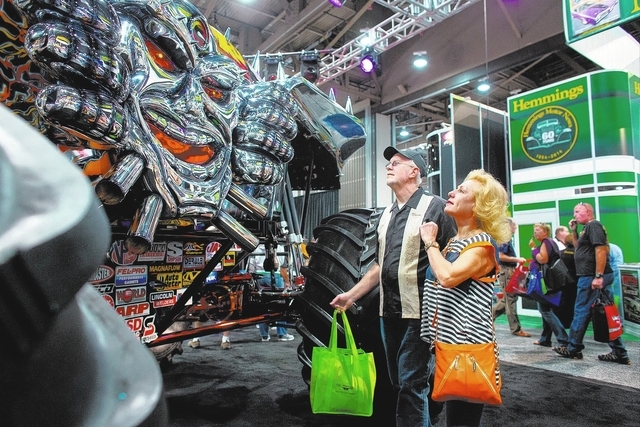Auto add-ons show for ‘everything you want but nothing you need’ rolls into Las Vegas
Dozens of fish played in an aquarium installed in the back of a customized sea-blue Toyota Highlander, an ode to SpongeBob SquarePants.
Yes, automotive dreams can come true.
The 2013 SEMA Show has taken over every inch of the Las Vegas Convention Center through Friday, attracting about 2,500 vendors, all featuring the coolest add-ons automotive enthusiasts could want to put on their rides. Roughly 130,000 people will fill more than 1 million square feet of space in and around the convention center. For the first time, SEMA has expanded into overflow space in the LVH.
“SEMA is everything you want but nothing you need,” said Peter MacGillivray, vice president of communications and events for SEMA.
The show is one-half of Automotive Aftermarket Industry Week, which includes SEMA, the Specialty Equipment Market Association convention, and AAPEX, the Automotive Aftermarket Products Expo. The latter is showing at the Sands Expo and Convention Center through Thursday.
Starting in 2009, the recession hit the SEMA Show hard, but this year’s event is shaping up to be one of the biggest in its 47-year history.
“The Specialty Equipment Market Association committed to Las Vegas more than three decades ago as we were evolving into a meetings and convention destination,” said Chris Meyer, vice president of global business sales for the Las Vegas Convention and Visitors Authority.
The SEMA show has been coming to Las Vegas every fall since 1977. Since then, Automotive Aftermarket Week has brought a cumulative attendance of more than 2.3 million people to the city, with an estimated nongaming economic impact of $2.8 billion. The two shows are scheduled to remain in Las Vegas through 2017 and will generate an estimated nongaming economic impact of more than $880 million between now and then.
This year, the two shows are expected to have an estimated nongaming economic impact of $176.1 million.
“In a lot of ways, a trade show will be a reflection of the industry it serves. In that way the numbers can play an important role for us,” MacGillivray said. “It gives us an idea of what kind of year we can anticipate. This is a record-breaking year for us.”
The show is open to industry only, but at 4 p.m. Friday the public is invited to come and watch as the customized cars leave the convention center. Grandstands will be provided.
And that’s the only time SEMA suggests you come out.
“We are such a consumer draw. There’s so much consumer interest in this show that the few that sneak in, they have a great time, but they erode the quality experience,” MacGillivray said. “They may pump up our numbers, but they erode the trade nature of the show. It’s something that we work very hard to protect.”
You see, the trade show is designed to be a place where qualified buyers and industry folks from the $31 billion specialty equipment sector can view the newest products and latest trends.
“You create value by filling the aisles with as many qualified buyers as possible, people who are here to buy container loads of product,” MacGillivray said. “The wheel guys aren’t here to sell four wheels at a time. They want to sell container loads.”
Between 60,000 and 70,000 buyers are attending, with another 60,000 to 70,000 media, exhibiting attendees and industry people making up the rest. The show attracts anyone in the specialty automotive chain from manufacturing to retail sales. About a decade ago, SEMA was primarily a domestic show, but this year international attendees comprise more than 20 percent of the total. MacGillivray said he thinks it’s because there are emerging markets around the world that have embraced automotive personalization, something that was historically an American pastime.
The association recently launched the SEMA Data Co-op, an initiative that helps small businesses get their data in line. It’s also investing in a product development center called the SEMA Garage where member companies can come and learn how to use tools that otherwise would be inaccessible to create products for their businesses.
“Those are two very big initiatives to us,” MacGillivray said.
SEMA also does a lot of work overseas bringing U.S. manufacturers into developing markets to sell their products.
“When the economy ebbs and flows in this market, our guys can be selling products in places like China or the Middle East and Russia, places where the economy may be in a different place in the cycle,” MacGillivray said.
SEMA’s membership consists of more than 6,000 member companies.
Contact reporter Laura Carroll at lcarroll@reviewjournal.com or 702-380-4588. Follow @lscvegas on Twitter.



